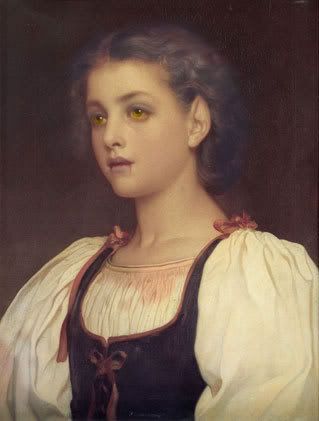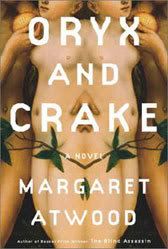Cyan in celluloid...
http://www.youtube.com/v/kS0g8Mrnzlk
Books
The Golden Bough by Sir James George Frazer
The Monsters: Mary Shelley & the Curse of Frankenstein by Dorothy & Thomas Hoobler
Russian Fairy Tales collected by Aleksandr Afanas'ev
Absinthe: History in a Bottle by Barnaby Conrad III
Les Liaisons Dangereuses by Choderlos de Laclos (in English translation)
Inside the Victorian Home: A Portrait of Domestic Life in Victorian England by Judith Flanders
Salome by Oscar Wilde with the original Aubrey Beardsley Illustrations (The English translation)
A Vampiress
I'm alive, honest...
I had a little surgery in the middle of November, and I always find that December is a good month for reflection. As a consequence of both of those things, I've been spending a lot more time on private thoughts rather than public ones.
I've also been preparing myself for Solstice. It's right around the corner, and there's much to be done...Unfortunately, it's not a favourite holiday of mine. I guess I'm a bit of a Scroogey McScrooge, but I'm trying not to be. I think I just need to work on developing my own traditions that don't involve the parts of the holiday that I consider to be negative.
Sci-Fi Meme
Anyhow, the deal is that I bold the ones I've read, italicize the ones that I've started but never finished, underline the ones that I own but have never started, strike out the ones I hated, and put an asterisk beside the ones I love.
2. The Foundation Trilogy, Isaac Asimov (I loved the first one. I'm not sure why I haven't finished the series)
3. Dune, Frank Herbert* (I love the first three novels of the Dune series.)
4. Stranger in a Strange Land, Robert A. Heinlein
5. A Wizard of Earthsea, Ursula K. Le Guin
6. Neuromancer, William Gibson (I'm not sure why I haven't finished this one. I like Gibson's style.)
7. Childhood's End, Arthur C. Clarke*
8. Do Androids Dream of Electric Sheep?, Philip K. Dick*
9. The Mists of Avalon, Marion Zimmer Bradley* (I loved this at one time. I haven't read it in years, and I don't know how I'd feel about it now. I think it was more of an adolescent kind of thing.)
10. Fahrenheit 451, Ray Bradbury*
11. The Book of the New Sun, Gene Wolfe
12. A Canticle for Leibowitz, Walter M. Miller, Jr.*
13. The Caves of Steel, Isaac Asimov
14. Children of the Atom, Wilmar Shiras
15. Cities in Flight, James Blish
16. The Colour of Magic, Terry Pratchett* (I only give this an asterisk because I love Discworld as a whole. This is the first book in the series, and they get better as you go along)
17. Dangerous Visions, edited by Harlan Ellison
18. Deathbird Stories, Harlan Ellison
19. The Demolished Man, Alfred Bester
20. Dhalgren, Samuel R. Delany
21. Dragonflight, Anne McCaffrey
22. Ender's Game, Orson Scott Card
23. The Chronicles of Thomas Covenant by Stephen R. Donaldson
24. The Forever War, Joe Haldeman
25. Gateway, Frederik Pohl
26. Harry Potter and the Philosopher's Stone, J.K. Rowling*
27. The Hitchhiker's Guide to the Galaxy, Douglas Adams (Why the hell haven't I finished this? Douglas Adams is great, and this is THE Douglas Adams novel.)
28. I Am Legend, Richard Matheson
29. Interview with the Vampire, Anne Rice
30. The Left Hand of Darkness, Ursula K. Le Guin* (Ursula Le Guin writes brilliant science fiction.)
31. Little, Big, John Crowley
32. Lord of Light, Roger Zelazny
33. The Man in the High Castle, Philip K. Dick
34. Mission of Gravity, Hal Clement
35. More Than Human, Theodore Sturgeon
36. The Rediscovery of Man, Cordwainer Smith
37. On the Beach, Nevil Shute
38. Rendezvous with Rama, Arthur C. Clarke
39. Ringworld, Larry Niven
40. Rogue Moon, Algis Budrys
41. The Silmarillion, J.R.R. Tolkien
42. Slaughterhouse-5, Kurt Vonnegut
43. Snow Crash, Neal Stephenson (This is another one that I don't know why I haven't finished it. I've really enjoyed what I've read.)
44. Stand on Zanzibar, John Brunner
45. The Stars My Destination, Alfred Bester*
46. Starship Troopers, Robert A. Heinlein
47. Stormbringer, Michael Moorcock
48. The Sword of Shannara, Terry Brooks
49. Timescape, Gregory Benford
50. To Your Scattered Bodies Go, Philip Jose Farmer*
Welcome to the world, little Ish
It's a girl, and she was born at 6:30 PM on November 13, 2006 in Loma Linda, CA.
7lb. 2oz.
and her name is Ishtar Anoushka.
I'm elated!
Rites of Passage
The last time that I was called, I ended up getting married on the same day as my civil service. Today, Christoph has jury duty, and I've received a call that one of my nearest and dearest friends is in labor. I'm so excited!
Denver Voting
My votes are in, and I'm happy. I didn't get everything that I wanted, but there were enough positive results to leave me feeling cheerful.
Halloween
In case you're wondering, the anachronistic bunny rabbit is my goofball of a husband, and I'm supposed to be a skunk, but everyone thought I was some sort of weird cat.
The Sensualist by Barbara Hodgson
 As an illustrated novel, The Sensualist contains a lot of eye-candy that specifically relates to the 16th century anatomist, Andreas Vesalius. I figure I should mention that right from the start, because it's eye-catching, and the first thing that I did before delving into the story was look at all of the beautiful pictures.
As an illustrated novel, The Sensualist contains a lot of eye-candy that specifically relates to the 16th century anatomist, Andreas Vesalius. I figure I should mention that right from the start, because it's eye-catching, and the first thing that I did before delving into the story was look at all of the beautiful pictures.The story, itself, begins in Austria and makes it's way into both Hungary and Germany. The reader follows Helen, an art historian, who is searching for her missing husband and becomes entangled in a mystery involving murder, anatomical art forgeries, and missing Vesalius woodblocks.
It would be impossible to give a really accurate description of how this book reads. It's surreal, and I often felt like I was reading the screenplay of a Jeunet and Caro flick. The characters are beyond eccentric. The settings are visual, and Hodgson's descriptions of the five senses are numerous and interesting. It was well worth my time, and I'll be looking into her other work in the future.
Singing Innocence and Experience by Sonya Taaffe
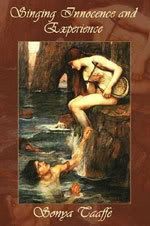 This volume contains some of the most brilliant prose that I've read in my lifetime. It's dense and well-crafted, and I've tried to take my time with it in an attempt to make it last. I've read and reread, and the feeling of absorbing Taaffe's lush and poetic imagery is like being intoxicated by a sweet and heady fruit that can only be found within the chronicles of myth.
This volume contains some of the most brilliant prose that I've read in my lifetime. It's dense and well-crafted, and I've tried to take my time with it in an attempt to make it last. I've read and reread, and the feeling of absorbing Taaffe's lush and poetic imagery is like being intoxicated by a sweet and heady fruit that can only be found within the chronicles of myth.My favourite stories are Constellations, Conjunctions, a wondrous tale about a woman made of stars, Shade and Shadow, a story of Orpheus and Eurydike and hungry ghosts, and A Maid on the Shore, a brief glimpse into the magic of the Selkie and the salty sea. Make no mistake, though. All of the other stories in this collection are worth their weight in gold especially if you have a love of myth, both classical and modern.
Henry Fuseli
Why am I here to relate the destruction of the best hope and the purest creature on earth? She was there, lifeless and inanimate, thrown across the bed, her head hanging down and her pale and distorted features half covered by her hair. Everywhere I turn I see the same figure--her bloodless arms and relaxed form flung by the murderer on its bridal bier. Could I behold this and live? Alas! Life is obstinate and clings closest where it is most hated. For a moment only did I lose recollection; I fell senseless on the ground. - Victor Frankenstein after the murder of Elizabeth by the creature.

Anna Karenina and Wuthering Heights
On Saturday morning, I finished Anna Karenina, and I must admit that I didn't care for it as much as I had hoped to. Tolstoy is fantastic in regards to characterization, and the novel was certainly well written, but he often lost my strict attention with frequent moralizing and drawn out forays into Russian politics. That's not to say that I don't understand the importance of the politics as they relate to the story, but it was all a bit long-winded for me. It's supposed to be one of Tolstoy's greatest novels, but I guess Tolstoy is just not my cup of tea.
In contrast, I started Wuthering Heights on Saturday evening, and I've barely been able to pull my attention away from it. I did manage to take a shower and brush my teeth, but beyond that, I've been hopelessly chained to the English moor. It's a dark and wicked story full of atmosphere, and it's perfect for October.
Mr. Vincent Price
Also, did you know that he wrote cookbooks? This is one of several, and the recipes don't even require a cauldron.
Spooky Short Stories - Part One
The Beckoning Fair One by Oliver Onions - Regarded by some as one of the best ghost stories written in the English language. Subtle and beautiful.
Rappaccini's Daughter by Nathaniel Hawthorne - Love blooms within a garden of poisonous flowers.
The Cask of Amontillado by Edgar Allen Poe - A brutal tale of revenge in which a man is buried alive.
The Wendigo by Algernon Blackwood - Based on a Native American Legend, this chilling story is set within the Canadian backwoods.
A Rose for Emily by William Faulkner - A southern gothic tale about an eccentric spinster and the skeletons in her closet.
The Reading and Procuring of Books
Anna Karenina by Leo Tolstoy
Singing Innocence and Experience by Sonya Taaffe
Purchased Yesterday at Borders
Journey to the End of the Night by Louis-Ferdinand Céline
Books That I'm Expecting in the Post
Moonwise by Greer Ilene Gilman
Chocolat by Joanne Harris
The Sensualist: An Illustrated Novel by Barbara Hodgson
Alabaster by Caitlin R. Kiernan
Daughter of Hounds (Pre-order) by Caitlin R. Kiernan
Only Revolutions - By Mark Z. Danielewski
These should keep me busy for a while.
Sad and Disturbed
The news is still coming in as the investigators feel comfortable with revealing certain details, and I must admit that I'm rather shocked that something like this has occurred in Bailey. I'm relatively certain that my response is naive, but it's difficult to imagine something so terrible happening in the small town that I know so intimately.
I'm sad for the community, and I can't get the sick feeling out of my stomach that tells me that something is terribly wrong with humanity. It's the same feeling that I get nearly every time that I read the news, but this time it's a bit more personal and thus, a bit more hard hitting.
Lyrebird
One More Day...
The other flora and fauna...well...they already know about her majesty's arrival, and they're doing all that they can to tidy up their homes and stock their pantries with food for the festivities. The leaves (foppish little things that they are) are beginning to dress themselves in their most colourful finery, and the royal detractors among them have sadly plummeted to their deaths littering the landscape with their brittle corpses. It's a pity, really. Her majesty is a much more benevolent ruler than Lord Winter.
Me? I'm a royalist at heart, and like the critters of the forest, I'm beginning to prepare my home for the coming of Autumn. I made a big pot of pea soup, an Indian recipe with lots of coriander and cumin and heavy cream. There are apples to be made into apple crisp, and there have been many pots of warm red-tea or coffee.
I've also been window shopping for warmer clothes and a pair of new boots but without much success... Parting with my sandals is the most difficult part of welcoming Autumn. Everything else comes absolutely naturally to me. She's such a beautiful entity, and this year, she'll be arriving with a gift. My soul sister in California is due to have her baby on November 11th, and I'm beyond excited. I've never wanted any children of my own, but I'm exhilarated by my friend's pregnancy. I get to play the role of aunt, which will be loads of fun. :)
India's Widows
The Living Dead
Rhadika Chalasani (Photojournalist)
India's Outcast Widows Have New Havens
Tewfic Al-Sawy (Photojournalist)
The Greying of India
Water (2005)
 Deepa Mehta was born and raised in India before emigrating to Canada in 1973. She has long been one of my favourite film directors, specificially because of her three elements trilogy.
Deepa Mehta was born and raised in India before emigrating to Canada in 1973. She has long been one of my favourite film directors, specificially because of her three elements trilogy.A brief description of the first two films:
Fire, released in 1996, is a controversial exploration of marriage and traditional gender roles in India. It tells the story of two women who, for varying reasons, experience frustration within their arranged marriages and eventually turn to each other for romantic companionship. Upon its release, Hindi fundamentalists attacked the theaters where the film was being screened, and as a result of that, the film was banned in India for a period of time.
Earth, released in 1998, is based on the novel "Cracking India" by Bapsi Sidhwa. It is the story of the partition of India as viewed through the eyes of a young Parsi girl living in Lahore, which was historically a multicultural city where Parsi, Sikh, Hindi, and Muslim families made their homes. Via a story between the girl's Hindi Ayah and the competing affections of two Muslim men, Mehta effectively portrays the rising religious tension that was present during the time of partition. This is perhaps the strongest film of the three.
I'm pleased to have been able to view the final film, Water, after being unsure of whether or not it would ever be completed. I've been waiting eagerly for many years, and it was well worth the wait.
Water takes place in 1938 before the partition of India, and it is the story of a young girl who is widowed at the age of seven and sent to live in an ashram for the remainder of her life. Traditionally, it was believed that a woman was half comprised of her husband, and when he died, a part of her died as well. Her choices at the time of his death were to burn on his funeral pyre, to marry her husband's brother, or to live all of her future days without pleasure in an ashram where she would make amends for the sins of her past lives which were said to be the cause of her current husband's death.
In addition to the young girl's story, Mehta also tells the stories of the other widows in the ashram, primarily, Kalyani, a young woman who has also lived in a house of widows since she was a very young girl. Unlike the other widows, her hair has not been cut, because she has been forced into prostitution as a means of supporting the head widow's ganja habit. It is her attempt at finding happiness despite the religious politics of India that acts as the catalyst of the film.
In 2000, Water was originally scheduled to be filmed on location at Varanasi, India where there still exist houses for widows, but the day before the filming began, there were sudden difficulties in obtaining the proper permits. A day later, thousands of Hindi Fundamentalist protesters stormed the set, burning it to the ground and throwing the remains into the Ganges. Mehta also received threats against her life, and at this point, it was clear that the filming could not continue in India. Eventually, the director, was able to continue the production in Sri Lanka, but because of the length of time that had passed between permits, she was forced to recast the film with younger actors. Water was finally shown in theaters in 2005, and it was released on DVD in late August of 2006.
The Dancing Girls of Lahore
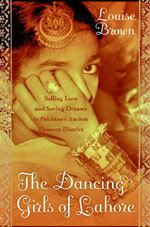 I've been reading The Dancing Girls of Lahore by Louise Brown, a teacher in the sociology department at the University of Birmingham in England.
I've been reading The Dancing Girls of Lahore by Louise Brown, a teacher in the sociology department at the University of Birmingham in England.Over a period of more than four years, Brown documented the lives of several individuals living and working in Heera Mandi, the red light district of Lahore. She interacts with many people in the community, and she describes their lives in vivid detail, but the author's greatest focus is on one middle aged dancer and her female children who are destined to follow in their mother's footsteps because of culturally imposed restrictions on class and gender. This is initially written with the eye of a scholar, but as time passes, Louise Brown becomes more personally attached to her subjects which lends itself to a more emotional and compassionate telling of their lives, culture, and historical role in Pakistan.
There is also quite a bit of information regarding religion, particularly the Shia branch of Islam. It's a fascinating and important book, particularly for those who are interested in gender studies as they relate to the Middle East.
Wishing on Stars
Carnivale
This week, Christoph and I have been watching the second and final season of Carnivale after waiting eagerly for more than a year. I was riveted by the series up until the very last episode which was unable to provide significant closure to a story that was initially scheduled to run for six seasons. I'm extremely frustrated by this, and it further compounds my distaste for television.
I understand that entertainment is a business based on money, but what happened to the art of telling a story? Isn't that equally important? It seems to me that allowing for quality television would actually increase revenues, but I guess my tastes just don't coincide with the majority.
At the very least, I'd like to see a mini-series that wraps up the loose ends of Carnivale. It's not the most favourable option, but at least its something.
Oryx and Crake
When I first began reading this book, I wasn't entirely taken by the author's use of language, but the further that I read, the more infectious the language became until I found that I couldn't put the book down. Atwood takes current societal issues and extrapolates on them, presenting one possible future in a witty and satirical manner.
The first thing that the reader understands is that the climate has changed drastically, obliterating once coastal cities and warming the Earth to such a degree that living in the open air is unhealthy and uncomfortable. A small number of priviledged families have escaped this discomfort by existing in self-contained compounds while profiting from those less fortunate and less esteemed than themselves. This larger portion of the population lives in the “Pleeblands,” an uncontrolled area riddled with crime and poverty.
Another major theme of the book is the negative effect that bioengineering could potentially have on the ecosystem and society if driven only by profit and without ethical consideration. There are several instances where the reader views scientists inflicting greater harm on the system in an attempt to right previous blunders or to “improve” the lives of human beings. Atwood's dialogue can be heavy-handed at times, but I didn't find it at all off-putting. In fact, I found that she often did well in pointing out how convenience and a situation where demand is greater than supply can lead to some rather absurd ideas on how to “fix” things.
One complaint that I initially had regarding this book is the lack of discussion of some of the characters' motivations, but the more that I think about it, the more that I feel that it's not important to Atwood's message. I'm not going to go into detail, which would result in spoilers, but I will say that I don't think it really matters if the intentions are good or bad when the result of an act destroys the entire world... I mean really, at that point, it's a little late to determine whether or not something was a good idea. Snowman certainly didn't get the chance to fully understand it, and this is his story.
Wood Troll
Hyperion and The Fall of Hyperion
I did go for a much needed walk in the park, and I nearly found myself covered in massive quantities of bird dren. There was a big splat several feet in front of me, and when I looked up, there was a beautiful hawk perched on a limb. I stayed and watched him in all of his elegance for quite a while before returning to my apartment, and now I'm here trying to decide what to do with the rest of my evening. It's exceedingly hot in this little box, and my ambition is not very high.
I was thinking about walking to my office to pick up an Amazon order that appears to have arrived on Saturday, but I'll probably wait until tomorrow to venture out again. I'm expecting Singing Innocence and Experience by Sonya Taaffe and The Dancing Girls of Lahore: Selling Love and Saving Dreams in Pakistan's Pleasure District by Louise Brown.
My Blogger Wishlist
- Tag/Categorization Support. I've seen some work-arounds, but it would be much better if it was integrated.
- I'd like to receive e-mail notification if I post a message at someone else's blog and they reply.
The Stars My Destination
Gully Foyle is my name
And Terra is my nation
Deep Space is my dwelling place
Death my destination
Gully Foyle has been stranded in deep space on the wreckage of the ship Nomad for 170 days. He has managed to survive by living in the only airtight space left on the ship and scavaging for food and air tanks within the short intervals that his air supply will allow. When a sister ship finally arrives and then abandons Gully to his fate, a murderous rage drives him to affect his own rescue and persue those who have abandoned him.
Thus marks the beginning of The Stars my Destination by Alfred Bester, which flowers into an intriguing tale about a future when humans have colonized the inner planets and several moons of jupiter. I don't want to say anything else about the plot, because I don't want to give any spoilers, but I will say that this is a compelling book that kept me reading at the expense of both food and sleep. Highly recommended.
Also, unusually, this is a book that I would like to see translated to film. I'm not sure if it's been adapted before.
The Ghost Pirates
Lovecraft said of the novel:
"The Ghost Pirates . . . is a powerful account of a doomed and haunted ship on its last voyage, and of the terrible sea-devils (of quasi-human aspect, and perhaps the spirits of bygone buccaneers) that besiege it and finally drag it down to an unknown fate. With its command of maritime knowledge, and its clever selection of hints and incidents suggestive of latent horrors in nature, this book at times reaches enviable peaks of power."
That's a pretty impressive recommendation, and I expected to devour this book, but it was actually a bit slow going for me. I appreciated the precise maritime language, but the atmosphere of subtle, creeping dread never got to me. It was only at the very end of the book that I really became fascinated with the "sea-devils," and of course, that was the climax of the story, and then it was over.
That's not to say that I didn't appreciate Hodgson's idea. I'm generally fascinated by the sea and the presence of ghosts. The presentation of this particular novel just wasn't effective for me.
Legendary Pink Dots
I just noticed that there are Pink Dots MP3s available for download on Epitonic.com which means that my only option is to proselytize.
Specific Recommendations:
Citadel
Spike
Dissonance
Art from Nature
 Kirk Rademaker creates brilliant machines out of sand. They have a definite steampunk aesthetic, and the attention to detail is amazing. It's somewhat sad that these pieces aren't made to last, but that's also a part of their beauty.
Kirk Rademaker creates brilliant machines out of sand. They have a definite steampunk aesthetic, and the attention to detail is amazing. It's somewhat sad that these pieces aren't made to last, but that's also a part of their beauty.I actually came across quite a few other fantastic sand artists, and I may give them a post all to themselves when I have a moment.
 Robert Smithson was an American land artist and a pioneer of the land art movement.
Robert Smithson was an American land artist and a pioneer of the land art movement.Spiral Jetty, which resides at the Great Salt Lake in Utah, is his most famous work. It's 1500 feet long and composed of rocks, earth, salt, and red algae. I think it's absolutely beautiful, and interestingly, it's not always visible because of the fluctuation in the water level.
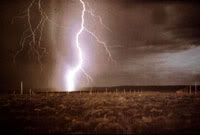 Walter De Maria, another land artist, created the Lightning Field in the high desert of New Mexico. It consists of 400 stainless steel poles spaced approximately 220 feet apart.
Walter De Maria, another land artist, created the Lightning Field in the high desert of New Mexico. It consists of 400 stainless steel poles spaced approximately 220 feet apart.Todd Gibson of From the Floor posted an interesting piece about his experience at the Lightning field. Contrary to what I believed, the lightning doesn't actually strike very frequently, but Gibson gives a good idea of what an experience at the lightning field is actually like. It's intriguing.
New Definition of "Planet"
"People love Pluto, children identify with its smallness," she writes. "Adults relate to its inadequacy, its marginal existence as a misfit." Sobel has several solar system models in her house. Asked if she had torn Pluto off any of them, she said "No, Pluto is definitely there."Not being a scientist, I don't have an opinion one way another about whether this particular definition is a good one, but I do have to ask how a child's love of Pluto relates to science?
The House on the Borderland
Two friends take a fishing vacation in a remote part of Ireland, and they stumble across the crumbling ruins of a stone house which has been overtaken by the foliage of a long untended garden. The house sits at the edge of a deep chasm into which flows a river of subterranean origin and also, as we soon find out, acts as a door to another dimension.
Within the rubble, the two men find the journal of an old man who once lived in the house, and they take the journal back to their campsite for further perusal. The tale that resides inside of that age-worn book is a masterpiece of the weird.
Imagine watching billions of years pass before your eyes in a matter of days, and you'll get the vaguest sense of the apocalyptic imagery that exists within this book. It's both haunting and surreal, and the story even features a chilling cameo by that darling of India, Kali the destroyer.
The only thing that I didn't care for is the inclusion of the ethereal love interest, and that's mostly because it was terribly underdeveloped. The reader gets a better sense of the relationship between the main character and the dog, Pepper (who I really liked). Had Hodgson left the romance bit out, this book would have been nearly perfect.
An online version of the text can be found at Project Gutenberg.
The Boats of the Glen Carrig
The Boats of the Glen Carrig is the story of a ship lost at sea and the strange adventures that befall the crew after they escape in two lifeboats and make their way into a wild Sargasso sea filled with dead ships and a plethora of monsters, some real and some otherworldly.
It's a page turner, and while there are some melodramatic bits, Hodgson is a master at creating an atmosphere of subtle, creeping dread. Highly recommended, especially if you like a good, imaginative yarn of the sea.
iPAQ 5455
 My husband brought me home an iPAQ 5455 which is very exciting for me as I read many books in e-format, particularly those in the public domain. I get them from sites like Project Gutenberg and The Literary Gothic. I also used to get them from Black Mask, but it's been missing in action, and I'm hoping for its eventual return.
My husband brought me home an iPAQ 5455 which is very exciting for me as I read many books in e-format, particularly those in the public domain. I get them from sites like Project Gutenberg and The Literary Gothic. I also used to get them from Black Mask, but it's been missing in action, and I'm hoping for its eventual return.Prior to receiving this lovely new toy, I was using a monochrome, handspring visor (cobalt blue), which worked wonderfully for me. It had some limitations due to its age and operating system. For example, I didn't have the ability to read microsoft reader files and the graphic capabilities were unimpressive to say the least, but I was able to read many amazing books on it, and it had the ability to take a large amount of abuse. I periodically fall asleep during late night reading sessions and drop my handheld computer on the floor which never seemed to phase it. This machine seems to be a bit more fragile, and I'll have to take greater care with it, but I'm really excited about the prospect of color, the ability to play music, and internet connectivity!
I know many people who just can't fathom the idea of reading a book on a computer screen. It lacks the tangibility and the romanticism of paper, but there are advantages as well. Reading in the dark without having to worry about waking anyone up is great, and I like to be able to store many different books and take them with me. It works well for rapidly changing moods.
Of course, there are some books that I still feel the need to own in a more tangible form, and I don't think I'll ever get over that, but there's something to be said for paperless communication.
The Glass Armonica
 About a month ago my husband and I watched Mesmer and became completely infatuated with a musical instrument that appeared in the film. It was composed of nested cylinders of glass which were rotated on a spindle, and at the touch of human hands, vibrated in much the same way that a wine glass vibrates when you run a wet finger along the rim.
About a month ago my husband and I watched Mesmer and became completely infatuated with a musical instrument that appeared in the film. It was composed of nested cylinders of glass which were rotated on a spindle, and at the touch of human hands, vibrated in much the same way that a wine glass vibrates when you run a wet finger along the rim.
At the time, we didn't realize that this instrument is called the Glass Armonica, and it was invented by Ben Franklin in 1761. He had heard another artist playing the wine glasses, and he decided that he could devise an instrument that would have the same qualities but with greater functionality.
The instrument became very popular in its day, and it's history is nearly as interesting as the sound that it creates. Several artists, including Mozart and Beethoven, composed pieces for the Glass Armonica, and Marie Antoinette took Armonica lessons, however, the instrument began to lose its popularity when rumours began to spread inferring that the instrument was a cause of insanity.
According to the German musicologist, Friedrich Rochlitz:
There may be various reasons for the scarcity of armonica players, principally the almost universally shared opinion that playing it is damaging to the health, that it excessively stimulates the nerves, plunges the player into a nagging depression and hence into a dark and melancholy mood, that it is an apt method for slow self-annihilation… Many (physicians with whom I have discussed this matter) say the sharp penetrating tone runs like a spark through the entire nervous system, forcibly shaking it up and causing nervous disorders.
As these types of rumours continued to spread, the popularity of the instrument waned, but it's still possible to purchase one, and there are still composers such as William Zeitler who claim the Glass Armonica as their primary instrument. I definitely recommend checking out Mr. Zeitler's site, as it's filled with interesting historical information about the instrument.
Also, if you'd like to hear the glass armonica, there's an article at PBS.org that has a soundclip.
There's also an interactive “virtual armonica” that you can play.
Thank you to hardrockzombie in the darkvictoria community for shedding some light on this enigmatic instrument! This is the kind of thing that I adore.
Gothic Americana
"Whether it is called Gothic country, American Gothic or Gothic folk, the sound is dark, plainspoken and often morose. Sometimes it's morbid, yet it's also often uplifting - and always thoughtful."
My personal favourites are Munly and the Lee Lewis Harlots, Woven Hand, and Sixteen Horsepower which make frequent rounds in my CD player, but the others a worth a listen as well.
Munly and the Lee Lewis Harlots
Woven Hand
Sixteen Horsepower
Lilium
Denver Broncos
Slim Cessna's Auto Club
Tarantella
Denver Gentlemen
DeVotchka
Urban Exploration
At the time, I was unaware of some of the brilliant, urban exploration artists that are out there documenting these places that most of us will never see. Slowly, but surely, I'm seeking them out on the web, so that I can live vicariously through their work. Here are a couple of links that I like.
Rana X - Sexy, derelict buildings with the occasional beautiful girl.
Mello Photography - Check out the power plant shots. Nice.
Sleepy City - Dsankt takes beautiful, mad photographs.
Infiltration - An urbex webzine with a lot of great links to urban explorers all over the world. This is probably the best resource that I've found.
Abandoned Places - The LJ community where I discovered Rana X and Bill Mello. Definitely worth checking frequently, as there are a lot of talented artists that post on a daily basis.
Dusting off the Cobwebs
This blogger account has been in my possession for quite a while, and I think it's time to dust off the cobwebs.

